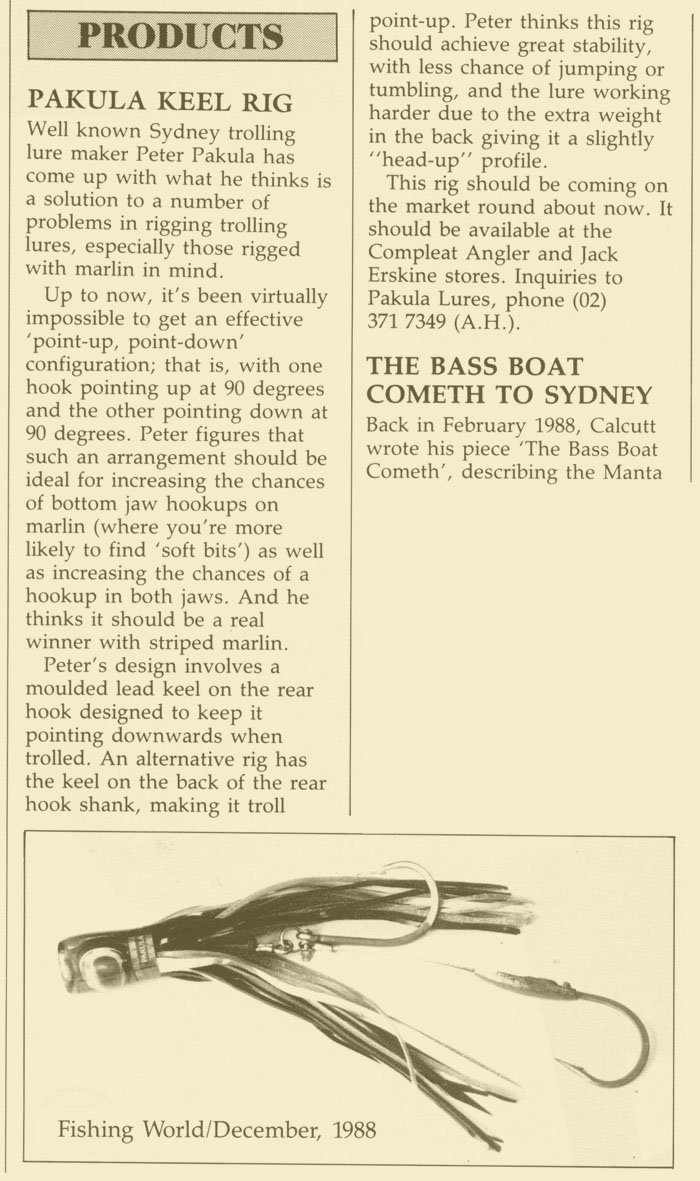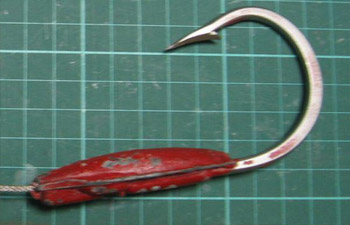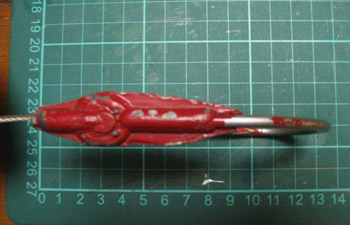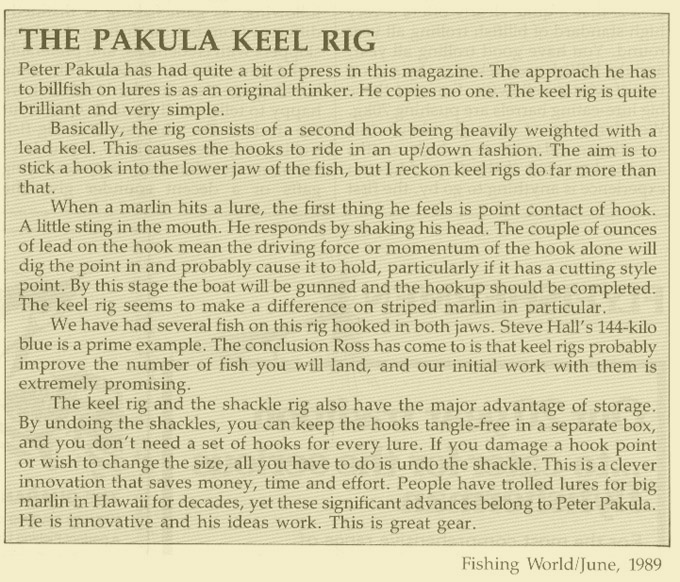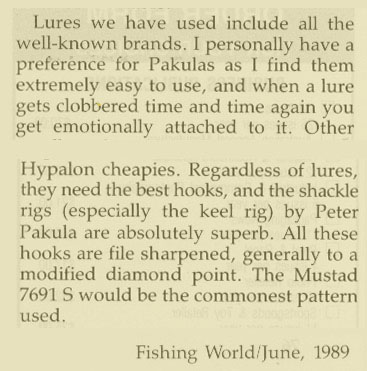Pakula Keel Rig Weights
The Pakula Keel Rig weights will increase your hook up rate on all Skirted Trolling Lures.
In their first year several anglers who were introduced to the Keel Weights in New Zealand enjoyed 100% success using them on usually difficult to hook Striped Marlin.
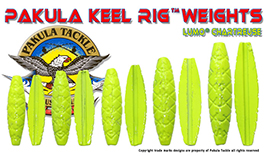
The Pakula Keel Rigs were first introduced in the late 1980's. Since then we have deleoped them to a point that anglers can easily adopt the system using the Pakula Keel Rig weights and increase their hook up rates considerably using any Skirted Trolling Lures.
Specifications
| Code |
Hook Size |
weight gm | length mm | width mm | height mm |
| PKW20 | 20 | 25 | 47 | 12 | 7 |
| PKW25 | 25 | 28 | 50 | 14 | 8 |
| PKW30 | 30 | 34 | 52 | 15 | 8 |
| PKW35 | 35 | 39 | 58 | 16 | 9 |
| PKW40 | 40 | 48 | 67 | 17 | 9 |
Keeping hook points in the hook-up zone
 By letting the lure find it's own balance and letting the hooks find their own balance you can increase their stability. Simply done by using ball bearing swivel in the rig. This separates the balance of the lure and rig and lets them do their own thing. Of course use the best quality swivel you can get and the rating should be more than the leader you are using, twice the rating is fine. As with all other gear you use, check it for strength before you use it. Note the piece of heat shrink that reduces the possibility of the rig wire hanging on the swivel ring. The ball bearing swivel is of most use with single hook rigs.
By letting the lure find it's own balance and letting the hooks find their own balance you can increase their stability. Simply done by using ball bearing swivel in the rig. This separates the balance of the lure and rig and lets them do their own thing. Of course use the best quality swivel you can get and the rating should be more than the leader you are using, twice the rating is fine. As with all other gear you use, check it for strength before you use it. Note the piece of heat shrink that reduces the possibility of the rig wire hanging on the swivel ring. The ball bearing swivel is of most use with single hook rigs.
Using the ball bearing swivel allows the lure to rotate through it's cycle while the hook point remains upright in the Hot Zone, To achieve that the hook bend and point needs to be positioned outside the lure skirt.
 Shackles also allow the hooks to balance themselves. They are incredibly strong for their size, but once again check them before using them. Shackles are of most benefit using twin hook rigs.
Shackles also allow the hooks to balance themselves. They are incredibly strong for their size, but once again check them before using them. Shackles are of most benefit using twin hook rigs.
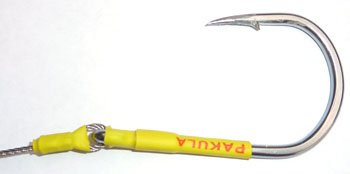 By splitting the heat shrink on the hook eye you allow the hook to find it's own balance easily. Often stiff rigging the hook eye area results in hooks spinning and lures that have a strong head shake will fatigue the wire resulting in the hook falling off, often blamed on tooth critters or tough fighting fish.
By splitting the heat shrink on the hook eye you allow the hook to find it's own balance easily. Often stiff rigging the hook eye area results in hooks spinning and lures that have a strong head shake will fatigue the wire resulting in the hook falling off, often blamed on tooth critters or tough fighting fish.
Note the heat shrink goes half way down the loop on the wire and half way up the hook eye. This reduces the chances of the hook hanging up on the wire loop. Use adhesive heat shrink on the hook.
If you want a stiff rig then using a support such as hard heat shrink with adhesive lining or thin garden irrigation tube should be used to support the rig. But....... once again you are restricting the action of the hook and the action of the lure. This may or may not be what you want to achieve.
Trollingr speed has an effect on the stability of the lure and rig. When you do your observations at the side of the boat it's important to see if your lures and rigs are stable at your higher trolling speeds. You'll find that many lures and rigs are quite stable at lower trolling speeds of 6,5 knots, but are unstable at higher speeds over 7.5 knots.
You can adjust lures actions at slower trolling speeds by adjusting the distance of the lures from the boat, the positions on the boats pressure waves and the height the the lures are trolled ie outriggers. Note that you don't have to troll lures off the tips of outriggers. The whole length of the outrigger offers adjustments all the way from their base to their tip.
A well balanced twin hook rig ie the 60O shackle rig will out fish a standard single hook rig (of course this depends on balance) mainly because the two hooks have double the keel of a single hook.
An easy way around getting this is keel the rig. The keels are just a long barrel sinker cut in half. I use a lot of them so mold my own in normal sinker molds, just pouring lead in half a mold. I also like panting them. As you can see I prefer Chartreuse as just about evey bait fish out there has a chartreuse tail.
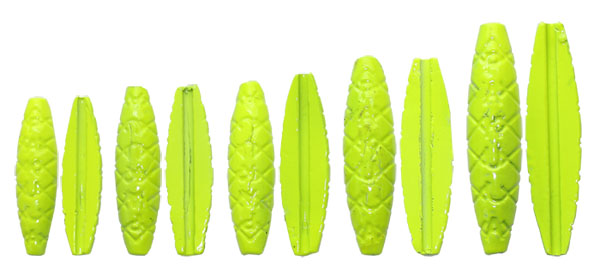
When using keels on rigs for fish that jump such as Marlin, Sails, Dorado the keel is attatched using a long skinny rubber band as shown below
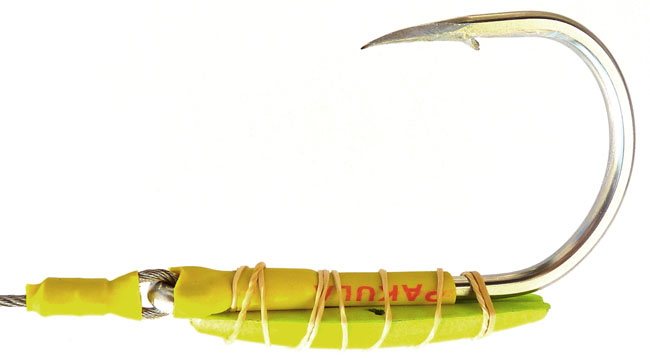
The keel sits flat half way up the eye of the hook to stop it rotating around the hook and you use enough wraps of the rubber band to stop the keel moving. The thin strands of the rubber band will wear through very quickly after the bite and fall off so it can't be used as a pendulum to throw the hook.
Using a keel will stabilise any skirted lure rig keeping the point in the Hot Zone. The weight of keel is relevant and should be checked through observation, but pretty much half a 4oz barrel sinker ie 2oz will keel most rigs from 9/0 to 11/0.
So a final rig that is very stable and offers maximum hook up rates will look like this:

The point will remain in the hot zone and allow the lure to do whatever it was designed to do. The length of the rig is important. The keel should be outside the skirt as much as practical with just the eye and the start of the keel inside the skirt.

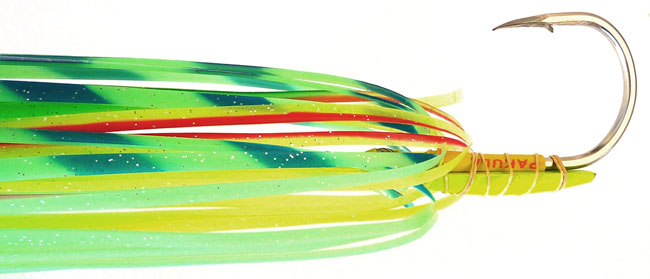
When using keels on twin hook rigs the keel is positioned so that it keels the angle you want to achieve. The image below shows a keel used on a 60 degree shackle rig where points are set at 30 degrees right and left, so the keel is set at an angle, not the bottom of the hook. Even though the 60 degree is one of the most stable rigs in rough choppy conditions where the water is turbulent the keel enhances the lures stability.
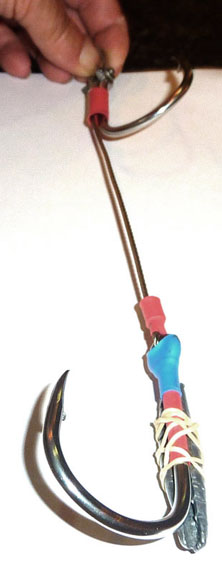
The main message of this article is to always question what you do regarding what you're lures and rigs are doing and confirming your opinions through observation.
It is always possible to improve your results. Hopefully you'll be able to find a system that is better than the examples given here. If you do please share it.
There are more advanced articles to come and I am still working on the DVD set Between the Lines 2 "Revelations"
How to Make a Keel Rig
Pakula Keel Rig Testamonial from NZ forum
Quote assassin_1
Report Post
Topic: Keeled Hooks
Posted: 10 Apr 2011 at 4:58pm
I have been trolling lures for the last two seasons, lots of strikes and not a single fish to the boat. Late last year I attended a seminar put on by Peter Pakula and decided the theory around the keeled rigs seemed to make sense and needed to be trialed.
Our first trip for the season and we had a double hook up and got both fish to the boat which were then released. Both fish firmly hooked in the top of the jaw. A very happy crew, maybe these keeled hooks do actually work.
Two weeks later we had our second shot and headed across the Manukau Bar, we had one strike and again firmly hooked a stripey in the top of the jaw. This one we kept for the smoker.
So now after two trips we have had three strikes, three solid hookups in the top of the jaw and 3 fish to the boat. After the previous two seasons we couldnt believe the change of fortune. We are beginning to really like these little sinkers fixed the the hook with a rubber band.
On Saturday 9th April we again decided on a trip out across the Manukau for our 3rd trip of the season. In very marginal conditions for a 5.5m Stabi we were trolling the lures for 1 hour and ten minutes when we had our 4th strike. Again a solid hookup and after 35 minutes we had the marlin in the boat. This one went 197kg and is the heaviest striped marlin caught in NZ this year.
So after 3 trips we have had four marlin from 4 strikes and all hooked in the top of the jaw. Considering the previous two seasons we had 20 strikes for no fish.
If anyone is having trouble getting hooks to stick, I would encourage you to try the rig designed by Peter Pakula. It has certainly been working for us.
A big thank you goes to Peter Pakula, attending his seminar and the videos on his web site has resulted in a fantastic season for us and I cant wait for the next seminar.
Pakula Keel Rig History
